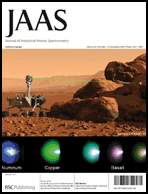Yesterday the Royal Society of Chemistry had the pleasure to meet the driver of the Mars Curiosity rover Paolo Bellutta who revealed the secrets of Mars one year after the first ‘landing’ in 2012.
You might remember the paper published in 2007 in JAAS about ChemCam, the powerful instrument now functional part of the Mars Science Laboratory Curiosity rover used to study the red planet.
ChemCam uses laser induced breakdown spectroscopy (LIBS) to remotely analyse the surface of Mars looking into the chemistry of its rocks.
Jean-Baptiste Servien and colleagues at CEA Saclay, France, introduced the three chemometric approaches used by ChemCam to study the rocks on the surface of Mars in the paper entitled Feasibility study of rock identification at the surface of Marsby remote laser-induced breakdown spectroscopy and three chemometric methods.
Last August, Curiosity successfully landed at Gale Crater on the planet Mars. Paolo Bellutta, Rover’s driver from NASA’s Jet Propulsion Laboratory, explained what is behind a one-ton vehicle that is able to land in such a hostile place where the wind runs at 400Km/h, the temperature reaches -90°C and the sky turns orange.
How do we drive on Mars? And what are we doing on Mars ? To know everything about the Mars Mission watch the video soon available on The Reaction website.
Free for you until May 13th: Feasibility study of rock identification at the surface of Mars by remote laser-induced breakdown spectroscopy and three chemometric methods
Jean-Baptiste Sirven, Béatrice Sallé, Patrick Mauchien, Jean-Luc Lacour, Sylvestre Maurice and Gérard Manhès
J. Anal. At. Spectrom., 2007, 22, 1471-1480
DOI: 10.1039/B704868H












